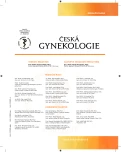Endothelial dysfunction in pregnancies with chronic hypertension
Authors:
J. Procházková 1; M. Procházka 2; L. Slavík 1; J. Úlehlová 1; I. Dhaifalah 4; M. Lubušký 2; O. Šimetka 3
Authors‘ workplace:
Hemato-onkologická klinika FN a LF UP, Olomouc, přednosta prof. MUDr. K. Indrák, DrSc.
1; Porodnicko-gynekologická klinika FN a LF UP, Olomouc, přednosta prof. MUDr. R. Pilka, Ph. D.
2; Porodnicko-gynekologická klinika FN, Ostrava, přednosta doc. MUDr. V. Unzeitig, CSc.
3; Ústav lékařské genetiky a fetální medicíny FN a LF UP, Olomouc, přednosta prof. MUDr. J. Šantavý, CSc.
4
Published in:
Ceska Gynekol 2013; 78(3): 230-236
Overview
Aim of the study:
To establish endothelial activation markers which could uncover endothelial damage during hysiological pregnancy and pregnacies with chronic hypertension.
Settings:
Department of Hemato-oncology, Obstetrics and Gynecology and Department of Medical Genetics and Fetal Medicine Medical Faculty of Palacký University Olomouc, Department of Obstetrics and Gynecology Medical Faculty Ostrava.
Methods:
We examined 298 pregnant women with a physiological pregnancy. Venous blood samples were collected from the women in both arms at the beginning of the pregnancy, a second sample was collected in the interval 24–28 weeks gestation, the third sample was colected about the 36 weeks of gestation. Parameters were examined using methods: t-PA – ELISA, PAI-1 – ELISA, vWF – EIA, ePCR – ELISA, MMP-2,9 – ELISA with fluorogenic detection, TIMP-2 – ELISA, endothelial microparticles – flow cytometry.
Results:
In accordance with the literature, we have observed in our study significantly increased endothelial activatition in hypertensive pregnancies compared with women with physiological pregnancy, as evidenced by significant increases in vWF activity and antigen, thrombomodulin and PAI-1 in all trimesters. In the other investigated parameters statistically significant changes were not observed.
Conclusion:
We have found significant signs of endothelial dysfunction in the group of women with pre-existing hypertension, a wide range of parameters examined markers indicating an significantly increased endothelial activation pregnant women with pre-existing hypertension, confirming the need for strict follow-up of pregnant women with hypertensive disease.
Keywords:
endothelium – activation – pregnancy – hypertension
Sources
1. Augustin, HG., Kozian, DH., Johnson, RC. Differentiation of endothelial cells: analysis of the constitutive and activated endothelial cell phenotypes. Bioessays, 1994, 16, p. 901–906.
2. Boffa, MC., Valsecchi, L., Fausto, A. Predictive value of plasmathrombomodulin in preeclampsia and gestational hypertension. Tromb Haemost, 1998, 79, p. 1092–1095.
3. De Caterina, R., Libby, P. Endothelial dysfunctions and vascular disease. Oxford: Blackwell Publishing, 2007, p. 3–32. ISBN: 978-1-4051-2208-5.
4. Friedman, SA., Schiff, E., Emeis, JJ., et al. Biochemical corroboration of endothelial in volvement in severe preeclampsia. Am J Obstet Gynecol, 1995, 172, p. 202–203.
5. Greer, IA., Ginsberg, J., Forbes, CHD. Women’s vascular health. Hodder Arnold, 2007, p. 85–102. ISBN 13 978-0-340-809976.
6. Hájek, Z., a kol. Rizikové a patologické těhotenství. Praha: Grada, 2004, p. 115–116. ISBN 80-247-0418-8.
7. Halligan, A., Bonnar, J., Sheppard, B., et al. Heamostatic, fibrinolytic and endothelial variables in normal pregnancies and pre-eclampsia. Br J Obstet Gynaecol, 1994, 101, p. 488–492.
8. Hoffbrand, AV., Catovsky, D., Tuddenham, EGD. Postgraduate hematology. Oxford: Blackwell Publishing, 2005, p. 787–807, 885–899. ISBN: 1-4051-0821-5.
9. Kvasnička, J. Trombofilie a trombotické stavy v klinické praxi. Praha: Grada, 2003, p. 22–29, 40–65, 99–113, 199–202. ISBN: 80-7169-993-4.
10. Nadar, SK., Yemeni, EA., Blann, AD., Lip, GYH. Thrombomodulin, von Willebrandfactor and E-selektin as plasma markers of endothelial damage/dysfunction and activation in pregnancy induced hypertension. Thrombosis Res, 2004, 113, 2, p. 123–128.
11. Petrák, O., Widimský, J. Jr., Zelinka, T., et al. Biochemical markers of endothelial dysfunction in patients with endocrine and essential hypertension. Physiol Res, 2006, 55, p. 597–602.
12. Sainani, GS., Vibhuti, GM. Role of endothelial cell dysfunction of essential hypertension. 2004, 52, p. 966–969, www.japi.org.
13. Vacek, Z. Embryologie. Praha: Grada, 2006, p. 54–55. ISBN 80-247-1267-9.
14. van Hinsbergh, VWM. Endothelium – role in regulation of coagulation and inflammation. Semin Imunopathol, 2012, 34, 1, p. 93–106.
15. Wilkström, AK., Nash, P., Ericsson, UJ., et al. Evidence of increased oxidative stress and change in the plasminogen activator inhibitor (PAI-1) – 1 to PAI-2 ratio in early-onset but not late-onset preeclampsia. Am J Obstet Gynecol, 2009, 201, p. 597.e1-8.
Labels
Paediatric gynaecology Gynaecology and obstetrics Reproduction medicineArticle was published in
Czech Gynaecology

2013 Issue 3
Most read in this issue
- Intrahepatic cholestasis of pregnancy
- Determination of anti-Müllerian hormone in women
- Antibiotic profylaxis in obstetrics
- Peripartum cardiomyopathy after caesarean section – a case report
